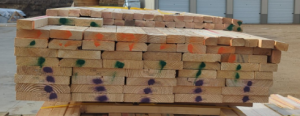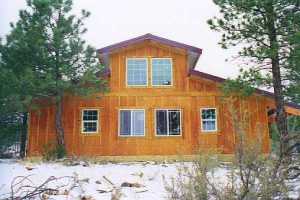Walk into your local lumber dealer – whether a big box store (aka The Home Depot® or Lowe’s®), a national lumber dealer (think ProBuild®, Stock Building Supply®, or 84 Lumber®) or the local mom and pop lumber seller and pickup any piece of dimensional lumber.
 On it will be a grade stamp – which is a voluntary standard of marking each piece of lumber to assist the consumer in identifying the moisture content, product grade, species or species grouping, the accredited agency under who’s authority the lumber was graded, as well as a unique mill number identifier or the name of the sawmill which produced the lumber.
On it will be a grade stamp – which is a voluntary standard of marking each piece of lumber to assist the consumer in identifying the moisture content, product grade, species or species grouping, the accredited agency under who’s authority the lumber was graded, as well as a unique mill number identifier or the name of the sawmill which produced the lumber.
One of my son Brent’s first days of working with me involved placing Simpson Strong-Tie® joist hangers on rafters. The rafters were different colored wood – Brent noticed the difference between the darker, more reddish hue of the Douglas Fir rafters as opposed to the whiter color of the ones which were HemFir. I explained to him what the information on the lumber grade stamps was, including the indication of the species of lumber.
The “big giant head” for lumber grading starts with the ALSC (American Lumber Standard Committee, Inc. www.alsc.org).
The ALSC, is a non-profit organization comprised of manufacturers, distributors, users, and consumers of lumber. It serves as the standing committee for the American Softwood Lumber Standard (Voluntary Product Standard 20) and in accordance with PS 20, administers an accreditation program for the grade marking of lumber produced under the system. This system, the American Lumber Standard (ALS) system, is an integral part of the lumber industry’s economy and is the basis for the sale and purchase of virtually all softwood lumber traded in North America. The ALS system also provides the basis for acceptance of lumber and design values for lumber by the building codes throughout the United States.
As noted above, a function of the ALSC is to maintain the American Softwood Lumber Standard. The ALSC in accordance with the Procedures for the Development of Voluntary Product Standards of the U.S. Department of Commerce and through a consensus process establishes sizes, green/dry relationships, inspection provisions, grade marking requirements and the policies and enforcement regulations for the accreditation program. The ALS system as a whole is set up to give manufacturers, distributors, users and consumers a mechanism to formulate and implement the Standard under which softwood lumber is produced and specified. Participation of each segment of the industry is an integral part of the program and provides the industry with a direct voice in the standardization and accreditation program as it evolves into the twenty-first century.
In the case of Brent’s rafters, the Douglas Fir ones were marked with the WWP® logo of the Western Wood Products Association (www.wwpa.org) which is the largest association of lumber manufacturers in the United States. The Douglas Fir ones were marked with a mill number to indicate the producer, however the others were produced by Idaho Timber (www.IdahoTimber.com).
The rafters happened to be graded as Select Structural (SelStr), which indicates a relatively smaller group of allowable defects than the more commonly seen framing material, which is normally graded as #2.
For a brief overview of allowable defects in lumber, please read more at: https://www.hansenpolebuildings.com/blog/2013/12/lumber-defects/
The species of lumber was how Brent and I originally got into the discussion of grade stamps. It was indicated by the DFir and HemFir designations on the rafters.
All of the framing lumber used on this building (as well as all Hansen Pole Buildings) is seasoned to a moisture content of no greater than 19% at time of surfacing, which was indicated by the “KD” on the grade stamps.
Lots of information contained in a little stamp – but as Brent’s older sister Allison says, “My Dad knows more worthless trivia than anyone”.








